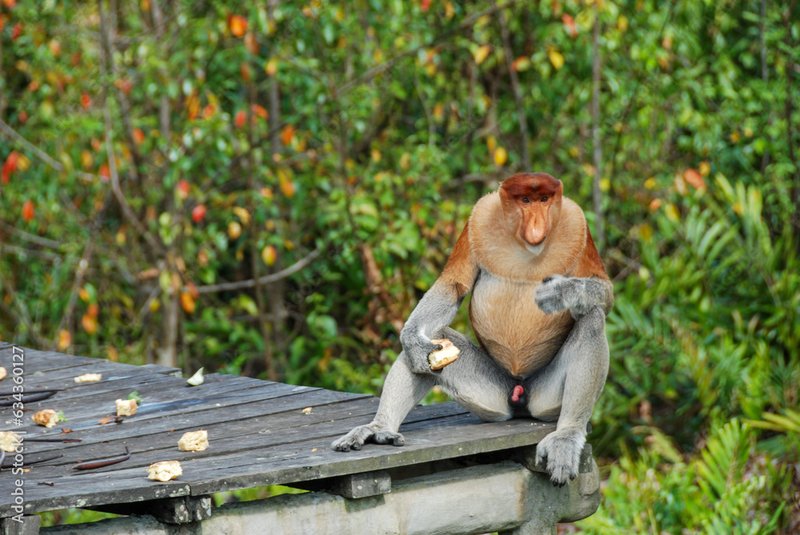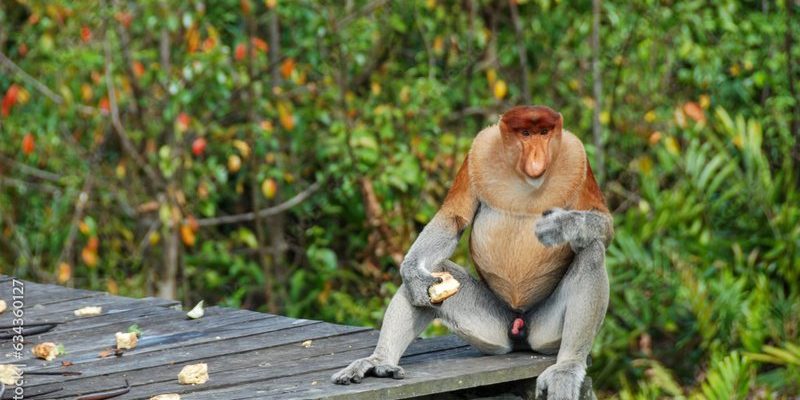
The Proboscis Monkey, with its strikingly long nose and round belly, is one of nature’s most interesting primates. Imagine a monkey with a nose that looks like it belongs in a cartoon! Found only on the island of Borneo, this fascinating creature is not just known for its unusual looks; it also has a host of unique behaviors and traits that make it stand out in the animal kingdom. So, what makes these monkeys so special? Let’s dive deeper into their world.
These monkeys are social animals often found in small groups. They thrive in the dense forests and mangrove swamps of Borneo, where they spend much of their time swinging through the trees, munching on leaves, and even taking a dip in the water. Their diets consist mainly of leaves, fruits, and seeds, which they expertly find in their lush, green surroundings. But there’s more to them than just their eating habits and funny noses. The Proboscis Monkey boasts some intriguing characteristics and behaviors that are worth exploring.
Physical Characteristics
The Proboscis Monkey isn’t just another primate; its appearance is as unique as its habitat. Adult males can weigh between 70 to 100 pounds, while females are typically smaller, weighing around 50 to 70 pounds. One of the first things that catch your eye is their nose, which can grow up to 7 inches long in males. This prominent feature isn’t just for show—it’s believed to play a role in attracting mates. The larger the nose, the more attractive a male might be to potential partners. Talk about a nose for love!
In addition to their distinctive noses, these monkeys have unique coloration. They sport a reddish-brown coat with a lighter underbelly. Their long limbs and tails help them navigate through the treetops with ease. With webbed feet, they are also great swimmers, which is unusual for monkeys. You might be surprised to see them glide through the water with grace, a skill that helps them escape predators like crocodiles.
Habitat and Distribution
You’ll find the Proboscis Monkey nestled comfortably in the lush rainforests and mangroves along the coastal areas of Borneo. They have adapted perfectly to their environment, relying on the rich biodiversity the island offers. The monkeys primarily inhabit riverine forests, which provide ample food sources and shelter. These areas are crucial for their survival, as they allow them to eat, socialize, and raise their young.
However, their habitat is under threat. Deforestation for agriculture and development has reduced their territory significantly. The loss of their natural environment means less food and fewer safe places to live. Conservation efforts are now more important than ever to ensure that the Proboscis Monkey and its habitat are protected. Initiatives include establishing wildlife reserves and educating local communities about the importance of preserving these remarkable creatures and their homes.
Diet and Feeding Habits
The Proboscis Monkey is primarily folivorous, which is just a fancy way of saying they mainly eat leaves. Their diet also includes fruits, seeds, and occasionally flowers. What’s interesting is their unique digestive system. They have a large stomach that ferments the tough plant materials, allowing them to extract as many nutrients as possible. This means these monkeys can live on a diet that many other primates would find hard to digest.
They spend a significant amount of their day feeding—up to several hours. You might spot them sitting in the treetops, plucking leaves with their dexterous hands while chatting with their companions. Their social feeding habits strengthen bonds within the group and keep them alert for potential dangers in their environment. It’s like having a lunch break with friends, where everyone interacts while enjoying their meal!
Social Structure and Behavior
Proboscis monkeys are incredibly social creatures, often seen lounging together or grooming one another—a behavior that helps strengthen social bonds within the group. Living in harems, which consist of one dominant male, several females, and their young, they maintain a strict hierarchy. The dominant male has breeding rights with the females, which means that younger males must wait their turn to mate. This society showcases a fascinating dynamic that ensures the survival of their kind.
These monkeys communicate using various vocalizations, ranging from honks to growls. The loud honks, in particular, can be heard for miles, serving as both a warning and a call to gather. Social interactions are crucial for their well-being, as they rely on each other for protection and support. You might think of their communities like a close-knit family, where everyone plays a role in helping one another thrive.
Reproduction and Lifespan
The breeding season for the Proboscis Monkey usually occurs year-round, but peaks during times when food is most abundant. A female typically gives birth to a single infant after a gestation period of about 5 months. Newborns are usually pale in color, making them easy to spot among the lush greenery. Mothers are very protective and will carry their babies for the first few months of life, gradually introducing them to the group.
Infants start to be weaned when they are around 6 months old, but they may continue to nurse occasionally for up to a year. In terms of lifespan, these monkeys can live up to 20 years in the wild. However, due to habitat destruction and hunting, many face significant threats that can shorten their lifespan. Conservation efforts play a vital role in ensuring that future generations of Proboscis Monkeys can thrive.
Conservation Status
Currently, the Proboscis Monkey is classified as endangered on the IUCN Red List. With their numbers rapidly declining due to habitat loss and hunting, conservationists are working tirelessly to protect these unique creatures. They rely on efforts like establishing protected areas and promoting sustainable practices in local communities to safeguard the environment.
Education and awareness are critical components of conservation. By informing local populations about the importance of protecting their natural habitats, we can create a sense of shared responsibility for the well-being of the Proboscis Monkey and other wildlife in Borneo. Additionally, ecotourism is emerging as a tool that can help fund conservation efforts while providing economic benefits to local communities. It’s a win-win situation for both people and monkeys!
| Characteristic | Details |
| Average Weight | 70-100 lbs (males), 50-70 lbs (females) |
| Average Height | About 26-30 inches tall |
| Habitat | Tropical rainforests and mangroves in Borneo |
| Diet | Leaves, fruits, seeds, flowers |
| Lifespan | Up to 20 years in the wild |
The Proboscis Monkey is more than just a quirky-looking primate. It’s a vital part of Borneo’s ecosystem and a symbol of the urgent need for conservation efforts in the region. By learning about these monkeys, we can appreciate their uniqueness and understand the challenges they face. Whether you’re a wildlife enthusiast or just curious about the natural world, the Proboscis Monkey is a captivating subject that reminds us of the beauty and fragility of life on our planet.
FAQ
What is the main habitat of the Proboscis Monkey?
The Proboscis Monkey primarily inhabits the coastal rainforests, mangroves, and swamps of Borneo. These lush environments provide ample food and shelter, making them perfect for their survival. The monkeys are specifically adapted to thrive in these wetland areas, where they can find plenty of leaves and fruits to eat.
How does the Proboscis Monkey communicate?
Proboscis Monkeys use a variety of vocalizations to communicate with each other. Their calls include loud honks, which can be heard from long distances. These sounds serve as warnings, mating calls, and ways to maintain social bonds within the group. This vocal behavior is crucial for their social interactions and overall community dynamics.
What do Proboscis Monkeys eat?
The diet of the Proboscis Monkey consists primarily of leaves, fruits, and seeds. They are known to be especially fond of young, tender leaves, which are easier to digest. Their unique digestive system allows them to break down tough plant material, which most other primates cannot digest properly.
Are Proboscis Monkeys endangered?
Yes, the Proboscis Monkey is currently classified as endangered due to habitat loss and hunting. Deforestation for agriculture, logging, and development has significantly reduced their natural habitat. Conservation efforts are underway to protect these unique primates and their environment, emphasizing the need for sustainable practices in Borneo.
Why do Proboscis Monkeys have such long noses?
The long noses of male Proboscis Monkeys are believed to play a role in attracting mates, as well as amplifying their vocalizations. A larger nose may signal to potential partners that the male is strong and healthy, making them more appealing during mating season. It’s nature’s way of showcasing attractiveness!
How do Proboscis Monkeys care for their young?
Mother Proboscis Monkeys are very attentive to their babies. Newborns are typically carried by their mothers for the first few months, during which they are protected and nursed. As they grow, mothers will start to introduce them to the group and encourage social interactions with other members.
Can Proboscis Monkeys swim?
Yes, Proboscis Monkeys are excellent swimmers! They have webbed feet, which help them glide through the water with ease. Swimming is an important skill for these monkeys, as it allows them to escape predators and explore new areas within their habitat. Watching them swim can be quite an entertaining sight!
Where can I see Proboscis Monkeys in the wild?
If you’re looking to see Proboscis Monkeys in the wild, Borneo is the place to be! They can be spotted in several national parks and wildlife reserves. Some popular spots include the Kinabatangan River and Bako National Park. Guided tours are often available, providing a chance to see these unique monkeys in their natural habitat.
What role do Proboscis Monkeys play in their ecosystem?
Proboscis Monkeys play an important role in their ecosystem as seed dispersers. By eating fruits and then traveling through the forest, they help spread seeds, aiding in the growth of various plant species. This not only benefits the monkey’s diet but also contributes to the health and diversity of their forest habitat.

